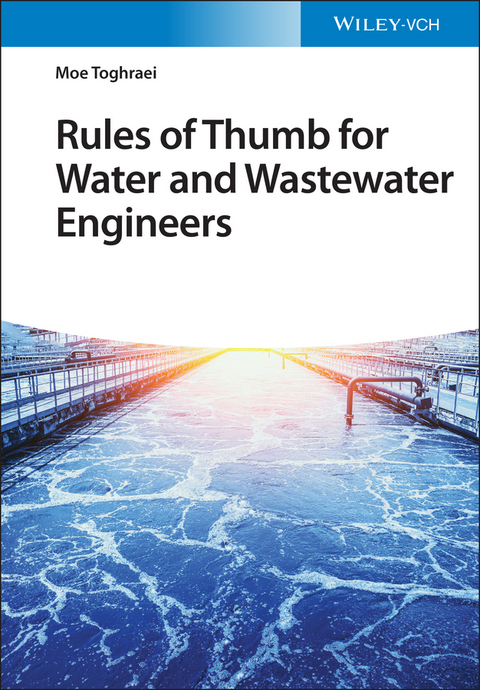Rules of Thumb for Water and Wastewater Engineers
Wiley-VCH (Verlag)
978-3-527-34885-5 (ISBN)
Water and wastewater treatment are essential processes in the water economy. It is generally separated by industrial and municipal processes, depending on the source of the wastewater and its intended use, ensures that water derived from processes is cleaned of industrial and biological contaminants and can safely be re-used for industrial processes, released back into the environment or is safe for consumption.
- Practical: Provides the engineer with a quick way to evaluate a situation and make quick decisions.
- Drawn from Experience: Rules of thumb are drawn from extensive practical experience and theoretical knowledge and are particular helpful to those new to water treatment.
- Wide Range: Water treatment is an essential part of almost all industries, such as the chemical, paper or textile industry, and of course for municipal water.
The book draws from considerable knowledge and experience to deliver rules of thumb for the areas potable water treatment, municipal wastewater treatment, industrial water treatment and industrial wastewater treatment. This allows engineers to evaluate situations quickly and estimate design decisions at a glance before a more detailed approach is taken.
Moe Toghraei is an instructor and consultant with Engrowth Training based in Calgary, Alberta, Canada. He has more than 20 years of experience in the chemical process industries. Moe has published articles on different aspects of chemical process operations, and has more than 10 years experience in training and designed dozen of courses for his company, and for other technical colleges.He holds a BSc. (in Chemical Engineering) from Isfahan University of Technology (Iran), and an M.Sc. in Environmental Engineering from Tehran University (Iran). He is a professional engineer (P.Eng) in the province of Alberta, Canada.
Part 1 - General
1.1 Water Resources - surface vs ground
1.2 Water Consumers
Part 2 - Water Contaminants
2.1 Settleables
2.1.1 (Dead) Particles
2.1.2 (Live) Organisms
2.2 Floatables
2.3 Dissolved
2.3.1 Dissolved Gases
2.3.2 Dissolved Ions
2.3.2.1 Specific Ions
2.3.2.1.1 Total hardness of Water
2.3.2.1.2 Alkalinity of Water
2.3.2.1.3 pH of Water
2.3.2.2 Total Dissolved Solids of Water
2.4 Colloids
2.5 Contaminants in different forms
2.6 Water Analysis
2.7 Water Temperature
Part 3 - Removal Methods
3.1 Settleable removal
3.1.1 Sedimentation
3.1.1.1 Universal g-force Sedimentation
3.1.1 Enhanced g-force Sedimentation (Cyclonic separation, Centrifugation)
3.1.2 Filtration
3.1.2.1 Conventional Filtration
3.1.2.2 Membrane Filtration
3.2 Floatable removal
3.2.1 Creaming
3.2.1.1 Universal g-force Creaming
3.2.1.2 Enhanced g-force Creaming (Cyclonic separation, Centrifugation)
3.2.1.3 Gas assisted Creaming (dissolved gas, dispersed gas flotation)
3.2.2 Filtration
3.2.2.1 Conventional Filtration
3.2.2.2 Membrane Filtration
3.2.3 Adsorption
3.3 Dissolved material removal
3.3.1 Dissolved Organic removal
3.3.1.1 Biological Treatment
3.3.1.2 Non-Biological Treatments (Adsorption, Ion exchange, Incineration)
3.3.1.3 Advanced Oxidation Treatment
3.3.2 Dissolved inorganic removal
3.3.2.1 Total Dissolved inorganic removal
3.3.2.1.1 Ion Exchange
3.3.2.1.2 Reverse Osmosis
3.3.2.1.3 Evaporation
3.3.2.2 Specific Ion removal
3.3.2.2.1 Precipitation
3.3.2.2.2 Selective Ion Exchange
3.3.3 Dissolved Gas removal
3.3.1.1 Stripping
3.3.1.1 Removing by considering as dissolved organics or inorganics
3.4 Colloid Removal
3.4.1 Direct Colloid Removal
3.4.2 Colloid Removal by converting to solid
3.5 Dealing with live organisms
Part 4 ? Process Development
4.1 Water management
4.2 Equalization
4.3 Treatment strategy
4.4 Pre-and Post- treatment
| Erscheinungsdatum | 18.03.2022 |
|---|---|
| Verlagsort | Weinheim |
| Sprache | englisch |
| Maße | 170 x 244 mm |
| Gewicht | 846 g |
| Einbandart | gebunden |
| Themenwelt | Naturwissenschaften ► Chemie ► Technische Chemie |
| Technik ► Bauwesen | |
| Schlagworte | Abwassertechnologie • Bauingenieur- u. Bauwesen • chemical engineering • Chemie • Chemische Verfahrenstechnik • Chemistry • Civil Engineering & Construction • Civil Engineering & Construction • Hydraulic/Water Engineering • Hydraulik • Hydraulik, Wasserbau • Process Engineering • Prozesssteuerung • Wasserchemie • water chemistry |
| ISBN-10 | 3-527-34885-9 / 3527348859 |
| ISBN-13 | 978-3-527-34885-5 / 9783527348855 |
| Zustand | Neuware |
| Informationen gemäß Produktsicherheitsverordnung (GPSR) | |
| Haben Sie eine Frage zum Produkt? |
aus dem Bereich




